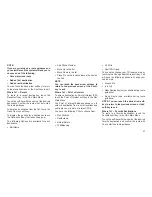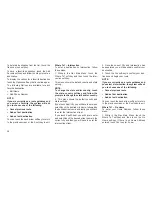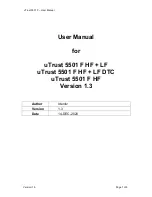
•
If necessary, use a lint-free cloth dampened
with a cleaning solution, such as isopropyl
alcohol, or an isopropyl alcohol and water
solution ratio of 50:50. Be sure to follow the
solvent
manufacturer’s
precautions
and
directions.
FCC Declaration
This device complies with Part 15 of the FCC
Rules and with Industry Canada license-exempt
RSS standard(s). Operation is subject to the
following two conditions: (1) this device may not
cause harmful interference, and (2) this device
must accept any interference received, includ-
ing interference that may cause undesired op-
eration.
NOTE: This equipment has been tested and
found to comply with the limits for a Class B
digital device, pursuant to Part 15 of the FCC
Rules. These limits are designed to provide
reasonable protection against harmful inter-
ference in a residential installation. This
equipment generates, uses and can radiate
radio frequency energy and, if not installed
and used in accordance with the instruc-
tions, may cause harmful interference to
radio communications. However, there is no
guarantee that interference will not occur in
a particular installation.
If this equipment does cause harmful interfer-
ence to radio or television reception, which can
be determined by turning the equipment off and
on, the user is encouraged to try to correct the
interference by one or more of the following
measures: - Increase the separation between
the equipment and receiver. - Consult the studio
or an experienced radio technician for help.
Safety Information
Exposure to Radio Frequency Radiation
The radiated output power of the this internal
wireless radio is far below the FCC radio fre-
quency exposure limits. Nevertheless, the wire-
less radio shall be used in such a manner that
the radio is eight inches (20 cm) or further from
the human body.
The internal wireless radio operates within
guidelines found in radio frequency safety stan-
dards and recommendations, which reflect the
consensus of the scientific community.
The radio manufacturer believes the internal
wireless radio is safe for use by consumers. The
level of energy emitted is far less than the
electromagnetic energy emitted by wireless de-
vices such as mobile phones. However, the use
of wireless radios may be restricted in some
situations or environments, such as aboard
airplanes. If you are unsure of restrictions, you
are encouraged to ask for authorization before
turning on the wireless radio.
51
Summary of Contents for 6.5N
Page 1: ...Owner s Manual Supplement Uconnect 6 5N...
Page 2: ...TABLE OF CONTENTS 1 UCONNECT 6 5N 3 2 SAFETY GUIDELINES 49 1...
Page 3: ...2...
Page 6: ...Uconnect 6 5N System 5...
Page 50: ...2 SAFETY GUIDELINES Safety Guidelines 50 49...
Page 53: ......
Page 54: ...Second Edition Uconnect 6 5N Chrysler Group LLC Printed in the USA 14UC65 526 AB...



































